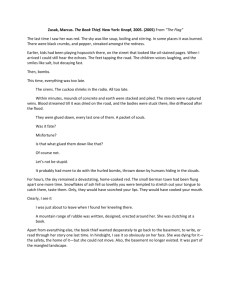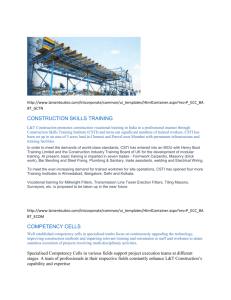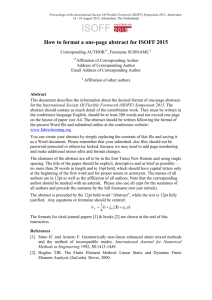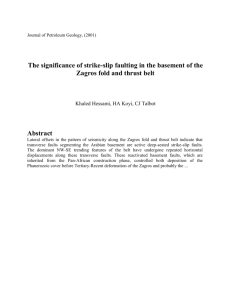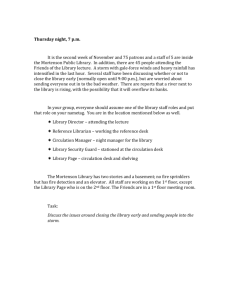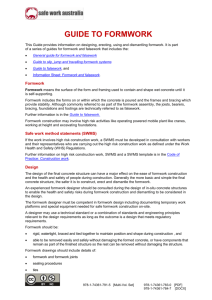Safety and Health Lessons Learnt
advertisement
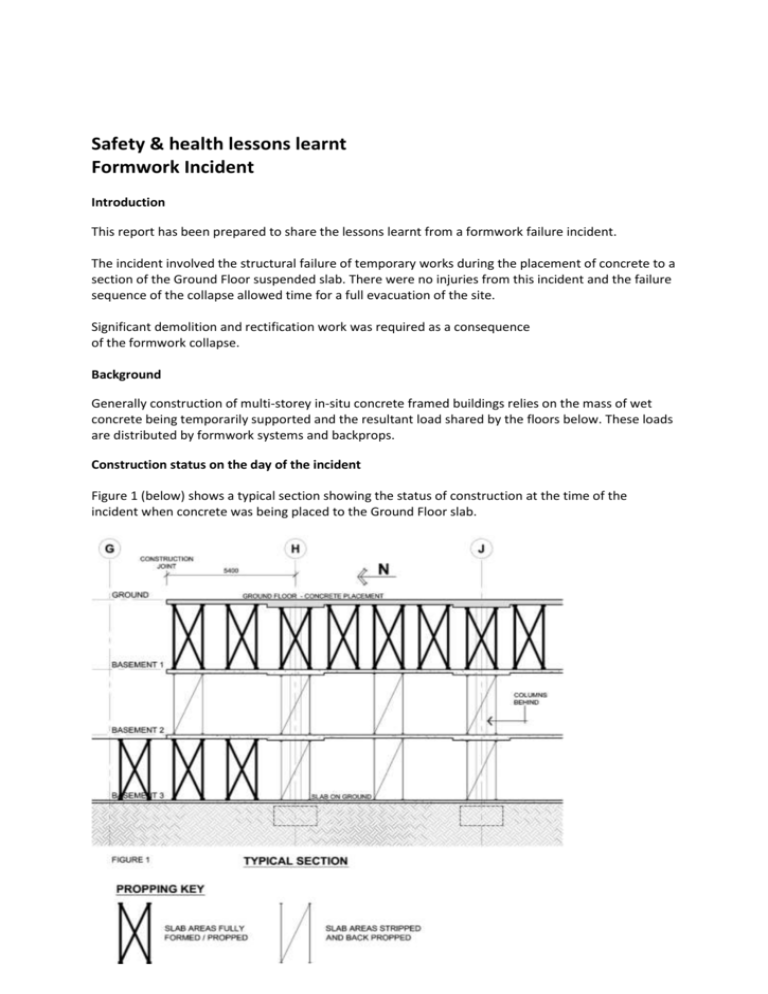
Safety & health lessons learnt Formwork Incident Introduction This report has been prepared to share the lessons learnt from a formwork failure incident. The incident involved the structural failure of temporary works during the placement of concrete to a section of the Ground Floor suspended slab. There were no injuries from this incident and the failure sequence of the collapse allowed time for a full evacuation of the site. Significant demolition and rectification work was required as a consequence of the formwork collapse. Background Generally construction of multi-storey in-situ concrete framed buildings relies on the mass of wet concrete being temporarily supported and the resultant load shared by the floors below. These loads are distributed by formwork systems and backprops. Construction status on the day of the incident Figure 1 (below) shows a typical section showing the status of construction at the time of the incident when concrete was being placed to the Ground Floor slab. The suspended Basement 1 and Basement 2 floor slabs are designed as post tensioned banded slabs and both suspended slabs had been fully stressed and grouted. The sections of Basement 1 and Basement 2 slabs north of Grid H were detailed with a construction joint at approximately 2/3 span towards Grid G. The sections of slab between Grid G and Grid H were completed up to the construction joint only. They would remain in this condition until adjacent slabs, north of the construction joint were formed and cast. With limited capacity to act as a cantilever, these slab sections relied on formwork and backpropping for support. Formwork and backprops on the day of the incident Figure 1 shows areas that were fully formed and propped and those which had been stripped and backpropped. In summary the installations were as follows: Between Basement 1 and Ground Floor the full formwork system was in place to support the wet concrete placement to the Ground Floor. Between Basement 2 and Basement 1 the formwork had been stripped and replaced with a system of backprops. Between Basement 3 and Basement 2, south of Grid H, the formwork had been stripped and replaced with the system of backprops. Between Basement 3 and Basement 2, north of Grid H, the formwork remained in preparation for casting Basement 2 north of the construction joint. Collapse sequence Figure 2 (below) highlights the sequence of the three failures that occurred, leading to the collapse of the formwork and wet concrete to the Ground Floor. Failure 1 – Backpropping between Basement 2 and Basement 1 As the concrete was being placed to the Ground Floor, north of Grid H, the Basement 2 to Basement 1 backprops became overloaded and began to progressively fail across the entire width (east to west) of the Basement 1 slab, a distance of some 32 metres. The progressive failure of the backprops produced visible deflections in the Basement 1 slab, north of Grid H, alerting site staff and leading to the safe evacuation of all site personnel. Failure 2 – Overloading of Basement 1 Slab, North of Grid H Failure 1 resulted in the full load of the Ground Floor wet concrete being carried by the now unsupported Basement 1 slab which in its temporary state, was now required to act as a cantilever. This load was in excess of the slabs structural capacity resulting in a progressive failure of the Basement 1 slab along the entire edge of the band beam (east to west) adjacent to Grid H. At Failure Point 2 a “hinge” was created at the band beam / slab junction at Grid H. As a result the northern most edge of the Basement 1 slab rotated downwards, coming to rest on the Basement 2 slab below. Failure 3 – Collapse of Ground Floor Formwork Without any support from the Basement 1 slab the formwork supporting the wet concrete to the Ground Floor (highlighted yellow in Figure 2) slid down the inclined surface of the collapsed section of Basement 1 slab and came to rest on the Basement 2 slab and formwork. The Basement 2 slab, north of Grid H, remained intact throughout the incident. The result of the three failure mechanisms outlined above is demonstrated in figure 3 (below). Lessons learnt Principal Contractors must ensure that formwork and backpropping design drawings are produced that are project and area specific. This is because design loadings for the permanent structure vary from floor to floor, particularly as the project progresses from basement levels, through the Ground Floor and into typical tower floors. The design drawings should take account of project specific issues such as: o pour sequence o concrete placement sequence and rate of placing o compaction methods The design should also be consistent with the project program. Design drawings must be certified by the formwork design engineer to demonstrate compliance with relevant Codes of Practice and AS3610. The Principal Contractor should verify the competency level and experience of the formwork and backpropping designer, including when the designer is appointed by the formworker under a subcontract arrangement. The Principal Contractor should develop the form and content of the formwork design certificate and include this certificate in the Formwork Subcontrator Agreement. The design certificate must satisfy the requirements of AS3610. The formworkers design engineer must ensure that the structural integrity of formwork systems and backpropping materials are verified before use. Materials inspection procedures from the subcontractor’s material suppliers should be provided that define the verification process. Principal Contractors must ensure that a review of the formwork and backpropping design is carried out by the Project Structural Engineer to verify that temporary imposed loads will not adversely affect the permanent structure. The Principal Contractor should verify the competency level and experience of the formwork and backpropping inspection engineer, including when the inspection engineer is appointed by the formworker under a subcontract arrangement. The Principal Contractor should develop the form and content of the installation certificate and include this certificate in the Formwork Subcontrator Agreement. This certificate must demonstrate compliance with relevant Codes of Practice and AS3610. Principal Contractors must maintain high levels of due diligence during formwork erection and accompany the Formwork Inspection Engineer on every inspection, and ensure they physically verify that corrective actions have been completed. Where possible minimise the time between inspection and concrete placement. The Principal Contractor should ensure that clear lines of responsibility and accountability are established and communicated through the design, inspection and certification process. The Principal Contractor should provide marked-up drawings to the formworker which identify the areas that can be stripped and backpropped prior to the formworker commencing those activities. The Principal Contractor should ensure they receive competency assessments for the formworkers workforce prior to commencement of works. Principal Contractors should also conduct their own competency assessment once works have commenced by doing task observations in the workplace.


